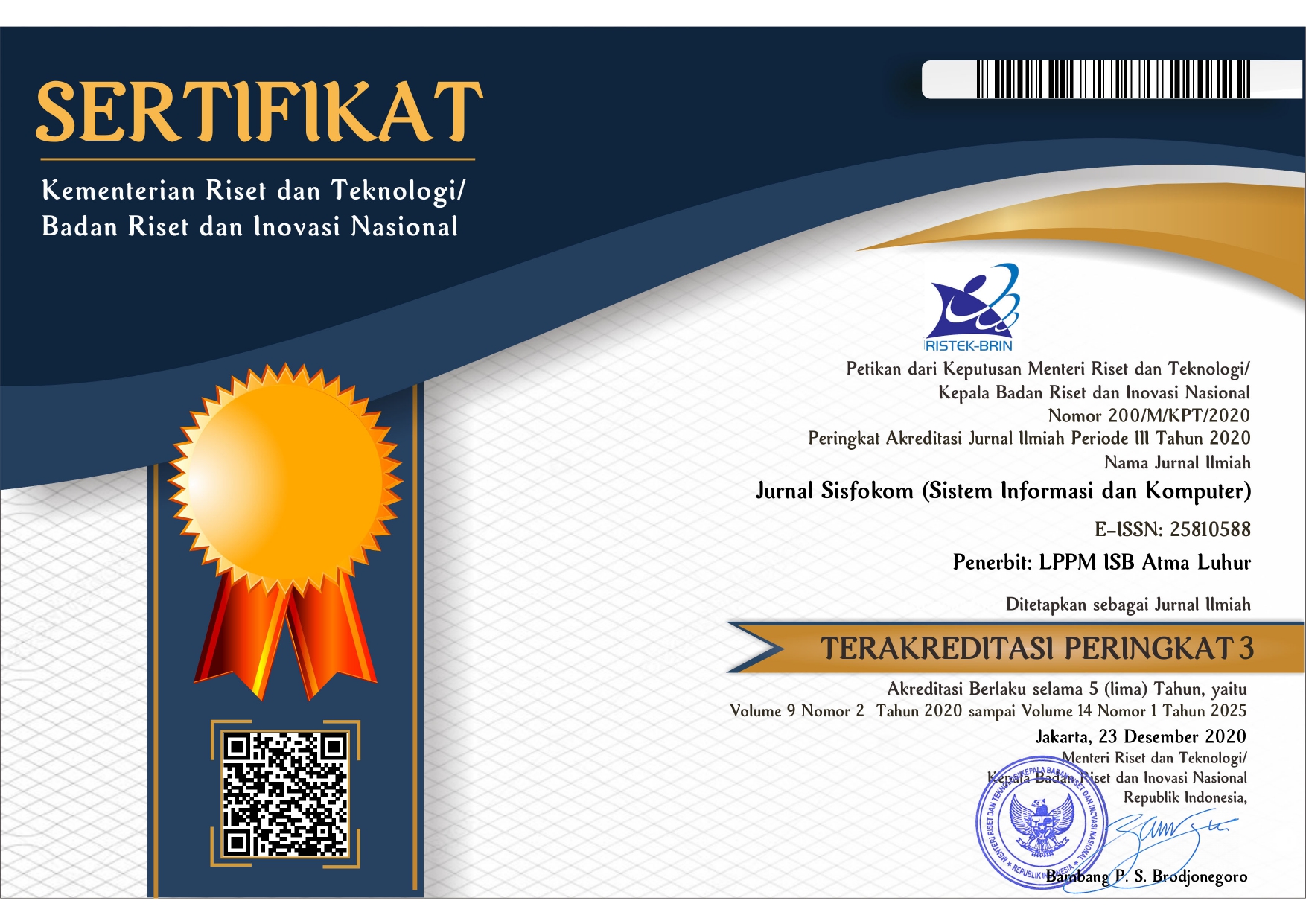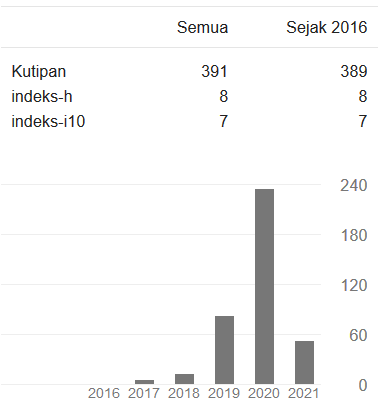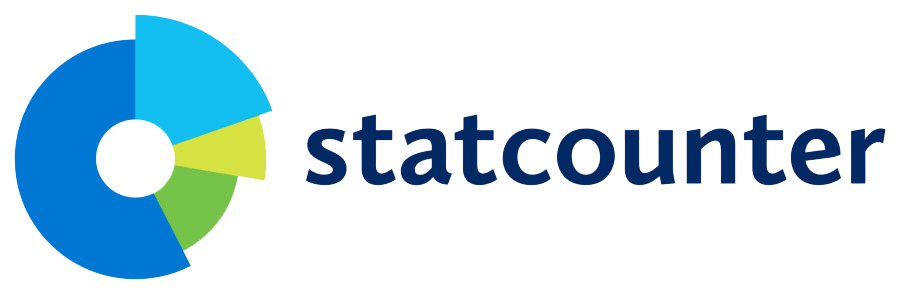Implementation Of Mamdani Fuzzy Logic In The Assessment System Of Merdeka Belajar Kampus Merdeka (MBKM) Activities: Case Study Of Mathematics Study Program At Bangka Belitung University
DOI:
https://doi.org/10.32736/sisfokom.v14i3.2394Keywords:
Mamdani Fuzzy Logic, MBKM, Assessment System, MATLAB, DefuzzificationAbstract
This study aims to apply Mamdani fuzzy logic in the assessment system of the Merdeka Belajar Kampus Merdeka (MBKM) activity to evaluate the effectiveness of student participation. This study was conducted on students of the Mathematics Study Program, Bangka Belitung University, class of 2021, involving four aspects of assessment: teamwork, basic skills, problem solving, and technological innovation. The method used is a descriptive quantitative approach with data processing using MATLAB software. Each input variable is converted into a fuzzy value through triangular and trapezoidal membership functions, followed by the preparation of if-then rules, Mamdani inference, and defuzzification using the centroid method. The results of the analysis show that the fuzzy system is able to produce an objective final assessment and in accordance with the assessor's policy, where students with dominant values at a high level get a final score of 83.7 and are categorized as "good". This study proves that Mamdani fuzzy logic is effective as a tool in the evaluation process of MBKM based on soft skills and hard skills in a comprehensive and measurable manner.References
R. Maulida, N. Yuniarti, dan H. Prasetyo, “Efektivitas implementasi MBKM dalam meningkatkan kompetensi mahasiswa,” Jurnal Pendidikan Indonesia, vol. 11, no. 3, 2022, pp. 213–224.
T. Suryani, S. Basuki, dan A. Putra, “Tantangan dan strategi implementasi MBKM di perguruan tinggi,” Jurnal Ilmiah Pendidikan, vol. 10, no. 1, 2021, pp. 55–64.
T. Prasetyo dan E. Trisnawati, “Persepsi mahasiswa terhadap program MBKM di era digital,” Jurnal Pendidikan dan Teknologi, vol. 8, no. 2, 2021, pp. 103–111.
R. Syahrir, R. Maulana, dan S. Dewi, “Penerapan MBKM dalam pembelajaran di masa pandemi: Studi kasus pada Universitas Negeri,” Jurnal Pendidikan Nasional, vol. 7, no. 2, 2022, pp. 88–95.
Kementerian Pendidikan dan Kebudayaan, “Kebijakan MBKM hasilkan dampak konkret, waktu tunggu lulusan perguruan tinggi lebih cepat,” 2023a. [Online]. Tersedia: https://www.kemdikbud.go.id/main/blog/2023/12/kebijakan-mbkm-hasilkan-dampak-konkret-waktu-tunggu-lulusan-perguruan-tinggi-lebih-cepat. [Diakses: 05-Mei-2025].
Kementerian Pendidikan dan Kebudayaan, “Kemendikbudristek fasilitasi lebih dari 36 ribu mahasiswa magang di perusahaan ternama,” 2023b. [Online]. Tersedia: https://www.kemdikbud.go.id/main/blog/2023/08/kemendikbudristek-fasilitasi-lebih-dari-36-ribu-mahasiswa-magang-di-perusahaan-ternama. [Diakses: 05-Mei-2025].
Direktorat Jenderal Pendidikan Tinggi, Riset, dan Teknologi, “Lebih dari 43 ribu mahasiswa mendaftar program Kampus Mengajar, terbanyak dari enam angkatan,” 2023. [Online]. Tersedia: https://dikti.go.id/kabar-dikti/lebih-dari-43-ribu-mahasiswa-mendaftar-program-kampus-mengajar-terbanyak-dari-enam-angkatan/. [Diakses: 05-Mei-2025].
P. Wardani, H. Mulyani, dan D. Rizky, “Pengukuran soft skills mahasiswa dalam kegiatan MBKM,” Jurnal Pendidikan Karakter, vol. 11, no. 4, 2021, pp. 205–216.
N. Farida dan I. Mukhlis, “Kendala dan peluang implementasi MBKM di PTN Indonesia,” Jurnal Pendidikan Tinggi Indonesia, vol. 6, no. 2, 2022, pp. 112–120.
A. Nugroho dan D. Kurniawati, “Perbandingan sistem penilaian subjektif menggunakan logika fuzzy,” Jurnal Sistem Cerdas, vol. 3, no. 1, 2022, pp. 35–42.
H. Yusnita, A. Pranata, dan B. Wijaya, “Pendekatan evaluasi berbasis logika kabur dalam dunia pendidikan,” Jurnal Teknologi Cerdas, vol. 4, no. 3, 2023, pp. 67–75.
A. Utami dan D. Yuliani, “Sistem pendukung keputusan evaluasi kinerja guru dengan Fuzzy Mamdani,” Jurnal Sains dan Teknologi, vol. 6, no. 1, 2020, pp. 13–21.
S. Rini, D. Sari, dan A. Hasan, “Aplikasi logika fuzzy dalam sistem penunjang keputusan penilaian proyek mahasiswa,” Jurnal Teknologi Informasi, vol. 14, no. 1, 2021, pp. 59–66.
N. Fitria dan M. Fauzi, “Sistem penilaian kinerja menggunakan fuzzy Mamdani,” Jurnal Sistem Informasi dan Teknologi, vol. 10, no. 1, 2020, pp. 25–31.
N. Zahra dan R. Nurjanah, “Sistem pendukung keputusan menggunakan fuzzy untuk penilaian kinerja karyawan,” Jurnal Teknologi dan Informasi, vol. 10, no. 4, 2022, pp. 145–153.
R. Andriani dan E. Supriyanto, “Pengembangan sistem evaluasi kinerja dosen menggunakan logika fuzzy Mamdani,” Jurnal Teknologi dan Sistem Komputer, vol. 9, no. 3, 2021, pp. 155–162.
A. Lestari dan A. Firmansyah, “Penilaian tugas akhir mahasiswa menggunakan Fuzzy Inference System Mamdani,” Jurnal Ilmu Komputer dan Aplikasinya, vol. 7, no. 2, 2020, pp. 44–52.
E. Siregar, H. Panggabean, dan R. Napitupulu, “Model evaluasi penilaian mahasiswa berbasis fuzzy logic,” Jurnal Teknologi Pendidikan, vol. 5, no. 1, 2021, pp. 72–79.
Downloads
Published
Issue
Section
License
Copyright (c) 2025 Baiq Desy Aniska, Randa Trezenki, Afina Shabirah, Novia, Lianawati

This work is licensed under a Creative Commons Attribution 4.0 International License.
The copyright of the article that accepted for publication shall be assigned to Jurnal Sisfokom (Sistem Informasi dan Komputer) and LPPM ISB Atma Luhur as the publisher of the journal. Copyright includes the right to reproduce and deliver the article in all form and media, including reprints, photographs, microfilms, and any other similar reproductions, as well as translations.
Jurnal Sisfokom (Sistem Informasi dan Komputer), LPPM ISB Atma Luhur, and the Editors make every effort to ensure that no wrong or misleading data, opinions or statements be published in the journal. In any way, the contents of the articles and advertisements published in Jurnal Sisfokom (Sistem Informasi dan Komputer) are the sole and exclusive responsibility of their respective authors.
Jurnal Sisfokom (Sistem Informasi dan Komputer) has full publishing rights to the published articles. Authors are allowed to distribute articles that have been published by sharing the link or DOI of the article. Authors are allowed to use their articles for legal purposes deemed necessary without the written permission of the journal with the initial publication notification from the Jurnal Sisfokom (Sistem Informasi dan Komputer).
The Copyright Transfer Form can be downloaded [Copyright Transfer Form Jurnal Sisfokom (Sistem Informasi dan Komputer).
This agreement is to be signed by at least one of the authors who have obtained the assent of the co-author(s). After submission of this agreement signed by the corresponding author, changes of authorship or in the order of the authors listed will not be accepted. The copyright form should be signed originally, and send it to the Editorial in the form of scanned document to sisfokom@atmaluhur.ac.id.









